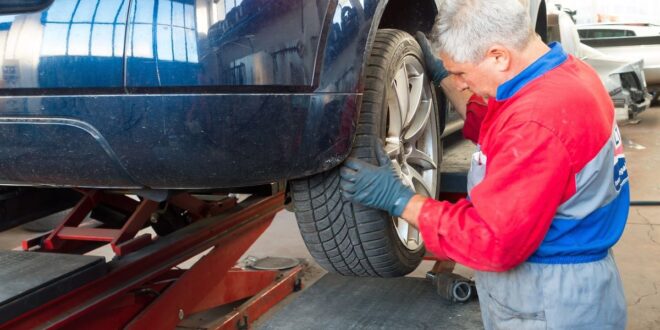Rotating tires is a practice where you change the positioning of the tires on your car to ensure they wear evenly. If you do this well enough, your tires will last longer, and you may just save some money. However, how often should you rotate tires?
Consider to rotate your tires every 5,000 to 8,000 miles (approx. 8,000KM – 12,800KM). Depending on your vehicle, you may rotate your tires using the Rearward Cross, X-Pattern, or Forward Cross. You even out the wear and prolong the age of your tires by rotating them.
This article explores how often you should rotate your tires. It starts with why people rotate their tires and how you can rotate your tires. We also discuss if you can rotate your tires too often and do you need alignment and balancing after rotating your tires.
Why Do People Rotate Tires?
Many people rotate their tires to ensure even wear on all four tires. Rotating tires also helps to keep tread depth uniform, reducing strain on your car. Finally, rotating tires reduces stress on your drivetrain and may help your car’s safety systems to work better.
Rotating tires may look a little odd and, in some people’s eyes, a waste of time. But there are reasons why it remains popular with many people. It helps to even wear, keeps tread depth uniform, and reduces stress on your drivetrain. Rotating tires also helps your car safety system to work.
Evens Out Tire Wear
Tires generally do not wear out evenly over time. Usually, tires that are controlled by the steering wheel may wear out earlier.
For example, if your car is a front-wheel drive, chances are your front wheels may wear out faster since you may be rubbing it against the road more when during sharp steering. The back tires usually do not turn too sharply, which means they may wear out slower.
Rotating your tires may help to ensure tires wear out evenly over time. In the case of a front-wheel drive car, the harder worn tires are brought back, so it gets to ‘rest.’ The hard work is now taken over by the back tires, which should be fresher.
Keep Tread Depth Uniform
By rotating your tires, what happens is that the tire’s tread wear may wear out more uniformly. This means you will have an event grip across your tires. This may improve your driving experience and avoid mishaps if you say perform emergency braking or steering.
On top of that, when your tires have a similar grip, your car’s safety systems may work better. Systems such as traction control and ABS may be great, but they still rely on your tire’s ability to grip the road. If your tire depth is uneven, chances are these computerized systems may not work well.
Reduces Strain On Your Drivetrain
When your tires have even treadwear, it also means the tires grip the road at similar strength. As a result, the force needed to move the tires will be similar across the axles.
This helps extend your drivetrain’s life, as it is not placed under an uneven strain. Drivetrains can be expensive to replace if broken down, which means rotating tires may help you avoid thousands of dollars in losses.
How Often Should I Rotate My Tires?
Consider rotating your tires at least once every 5,000 to 8,000 miles (approx. 8,000KM – 12,800KM). How often you rotate your tires may also depend on your driving conditions and the load you carry on your vehicle. Under-rotating may cause uneven wear, while over-rotating may be unnecessary.
The general advice for rotating tires is to do it once every 5,000 to 8,000 miles. In kilometers, that is approximately 8,000 – 12,800 KM. If you are wondering why the recommendation comes as a range and not a set number, there are reasons for it.
Generally, you may want to rotate your tires more evenly, depending on your tire and your driving condition.
Tire Type
Generally, the softer your tires are, the more frequently you should rotate them. This is because softer tires usually wear out and lose their tread depth faster. This means you may need to rotate the tires frequently to ensure a more even wear over time.
Softer tires may be more present in luxury or performance cars since softer tires give a better grip on the road and may be generally quieter.
Driving Conditions
If you are driving on rough roads or tight city traffic, chances are you may need to rotate your tires more. This is because the wear on the controller tires may be faster.
For example, if you drive and park in tight city traffic, you usually have to turn your steering a lot to get maximum turns from your wheels. This means you will rub your tires against the road much more.
Load
If your vehicle is used to carry heavy loads, you may also need to rotate your tires. This is because heavier loads may place more burden on your controlling tires, the ones controlled directly by your steering wheel. This means the treads may wear out faster.
Rotating tires more frequently here may help to ensure more even tire wear over time.
You may like this article: How Long Do Brake Pads Last?
How To Rotate My Tires?
You may rotate your tires using either the Rearward Cross, X-Pattern, or Forward Cross pattern. Your rotation pattern may depend on your drivetrains, preference, or if you want to have your spare tire in the rotation cycles.
| Rotation pattern | Suitable For |
| Rearward Cross | Cars with 4-wheel, all-wheel, or rear-wheel drive. |
| Forward Cross | All front-wheel drive vehicles, particularly passenger cars. |
| X Pattern | All front-wheel drive vehicles, such as light trucks and sedans. |
Generally, many people rotate their tires using either a Rearward Cross, X-Pattern, or Forward Cross pattern:
Rearward Cross
A Rearward Cross is recommended for cars with 4-wheel, all-wheel, or rear-wheel drive. You can execute this pattern by:
- Moving the back left tire to the front left.
- Moving the back right tires to the front right.
- Moving the spare tire to the back right.
- Moving the right front tire to the back left.
- Making the left front tire your new spare.
Forward Cross
A Forward Cross pattern is suitable for all front-wheel vehicles, particularly passenger cars. You can implement a Forward Cross by:
- Moving the back left tire to the front right.
- Moving the back right tire to the front left
- Moving the spare tire on the back right
- Moving the left front tire back to the back left
- The right front tire becomes the new spare tire.
X-Pattern
X-Pattern is suitable for front-wheel drive vehicles such as light trucks and sedans. It can be used if your car does not come with a full-sized spare or you prefer not to use your spare tire. An X-pattern is performed by:
- Moving the front left tire to the back right.
- Moving the front right tire to the back left.
- Moving the back left tire to the front right.
- Moving the back right tire to the front left.
Generally, all patterns work well, and there is no way to determine which rotation pattern is better than the other. The key is to first check your vehicle’s drivetrains, select suitable rotation patterns, and implement the rotation regularly.
Can Tires Be Rotated Too Often?
You can rotate your tires more often than the suggested mileage without damaging your tires or drivetrain. Over-rotating may be an unnecessary waste of time, effort, and money. However, Over-rotating is better than under-rotating, as over-rotating still keeps tire wear uniform. At the same time, under-rotating may cause uneven tire wear.
Common recommendations are to rotate your tire once every 5,000 to 8,000 miles. In kilometers, that is approximately 8,000 – 12,800 KM.
However, you may think of rotating your tires more frequently, say every 2,500 miles. It is not wrong to think so since some people generally care much about their cars. Some also wanted to ensure they got the maximum out of their tires.
The one good thing about over-rotating your tires is that they do not cause harm. You will not wear out your tires, nor do you place additional strain on your drivetrain. In fact, your tires may just wear out even more uniformly.
However, the gain you stand to make from rotating tires much more frequently than suggested may not be worth the additional time, effort, and money spent.
The more even tread wear may help to prolong your tires a little longer, but in the end, you may just spend more on rotating the tires than simply buying new ones when they wear out.
Nevertheless, over-rotating your tires may be a better thing to do than under-rotate. This is because under-rotating your tires can cause issues with uneven tread wear and premature replacement of your tires.
You may like this article: What Color Is Transmission Fluid?
Do I need Alignment And Balancing After Rotating the Tires?
Generally, you do not need to do any alignment or balancing after rotating tires. This is because changing the tires does not affect the alignment of the suspension. It also does not affect the balancing of your tires. You can, however, do them as preventative maintenance to ensure everything is in good condition.
At times, say you requested a tire change at a local tire shop and were asked if you wanted to have alignment or balancing work done on the tires. You do not need to accept it.
This is because rotating tires do not affect the car’s alignment or the tires’ balancing. Alignment may only be affected if the wheels are misaligned due to knocks. Wheel balancing may be lost if the balancing weights are dislodged during your driving.
In fact, by rotating your tires, you actually help to contribute to your car’s balance, stability, and traction. This is because you ensure even wear on your tires, which helps your drivetrain drive the wheels comfortably. You may also have a more balanced vehicle with a better grip on the road.
However, you can still consider performing an alignment or hand your car’s balancing checked as preventative maintenance. If you are already in a tire shop, you might as well spend a little bit more and have complete peace of mind.
 Being Human
Being Human




